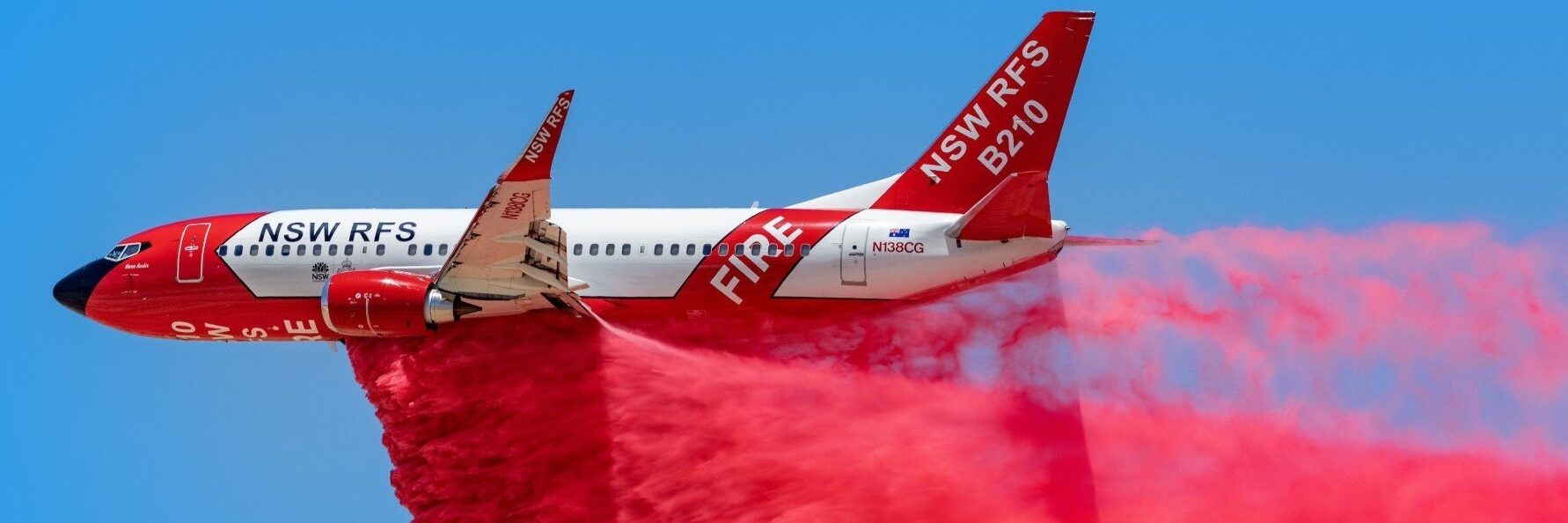The NSW RFS Boeing 737 firetanker which has also been deployed to North America. Photo: Coulson Aviation
Australia may not be able to continue to rely on the US and Canada for firebombing aircraft as global bushfire seasons start to overlap.
That was the assessment of Friends of the Earth Australia as Los Angeles continues to burn, echoed by the Climate Council.
Friends of the Earth campaigns co-ordinator Cam Walker is also an active volunteer firefighter.
“During our Black Summer, more than 1000 people came from North America to assist in firefighting efforts and Australia recently sent multiple teams to assist with the fires in North America,” he points out.
“This sharing of resources, including aircraft, firefighters and specialists, is how we fight fires in the 21st century.
“The fact that fires are raging in mid-winter in the US highlights that the world has entered a new phase (the pyrocene) and that our old ways of fighting fires needs to change,” Walker says.
He explains that Australia normally leases up to six Large Air Tankers (LATs), based in a state or territory but which are shared nationally. Australia has only one LAT, a converted Boeing 737 owned by the NSW Rural Fire Service) with one leased year-round.
Other planes are leased in after post-season maintenance in North America and arrive during the traditional ‘shoulder’ season, which is rapidly disappearing as planes are needed at ‘home’ for longer.
“As fire seasons extend in both hemispheres, we face the risk of being unable to secure leases for LATs in coming years,” Walker says.
Climate Council CEO Amanda McKenzie agrees with Walker’s sentiment.
“We are worried about the ability to share aircraft and personnel now and into the future as the climate crisis worsens,” she says.
“Beyond the loss of life and livelihood, lack of access to the tools we need to fight fires reinforces that slashing climate pollution this decade is so critical.
“These (LA) fires are a terrifying realisation for Australians watching events unfold in California, that fire crews are coping with longer and longer fire seasons. We must drive down climate pollution this decade, by ramping up our switch to renewable power.”
He also points to the Royal Commission into Natural Disaster Arrangements convened after the 2019-20 Black Summer which called for an Australian-based national fleet of aerial LATs.
“In light of all the available science about longer and more intense fire seasons in both hemispheres and the increased difficulty of securing LATs on lease from North America, the federal government must commit to establishing an Australian-owned fleet of LATs before the 2025-26 budget,” he says.

A NSW RFS Coulson C130 Hercules on the ground in Indonesia. Photo: NSW RFS/Flickr
FLEET NUMBERS
In July 2024, Canada’s Coulson Aviation announced a new $400 million 10-year contract with the NSW Rural Fire Service to manage and operate their fleet of a B737 Fireliner LAT, two Cessna Citations, six Bell-412 and a CH-47 Chinook (both helicopters) and a twin-engine Beechcraft Super King Air.
WA operates two grain harvest aerial firefighting fleets (two fixed wing water bombers and a support aircraft). The government also spent $10.1m to add two ex-military Blackhawk helicopters and will also use a C-130 Hercules LAT as part of its 36-aircraft strong fleet.
South Australia spent $26.7m to add five new aircraft to their fleet of 31 aircraft.
Queensland operates 13 aircraft including a LAT and Tasmania received 15 aircraft from the National Aerial Fighting Centre (NAFC) which operates more than 100 aircraft.
Victoria has 54 aircraft apart from the NAFC fleet including two aircranes which are due to join them from North America after their service ends.





